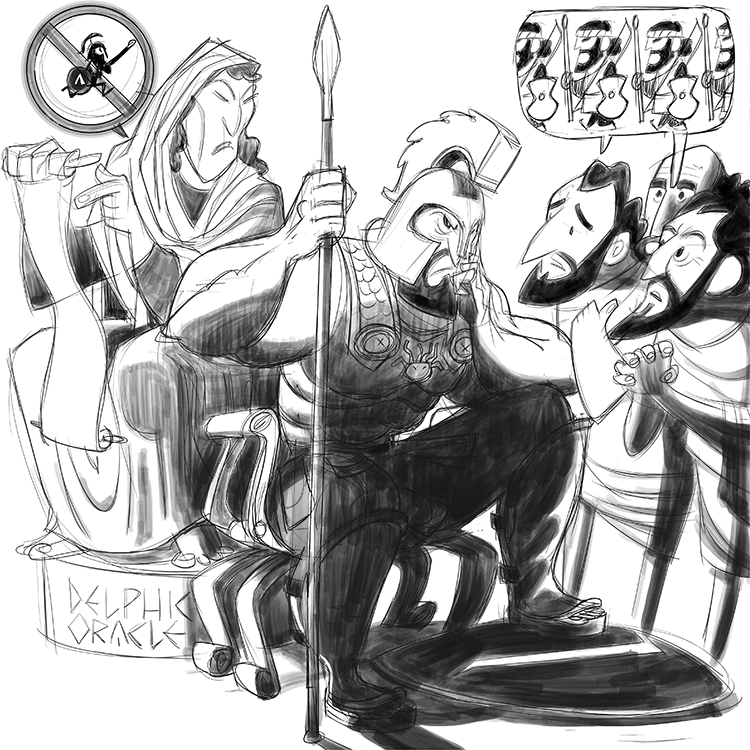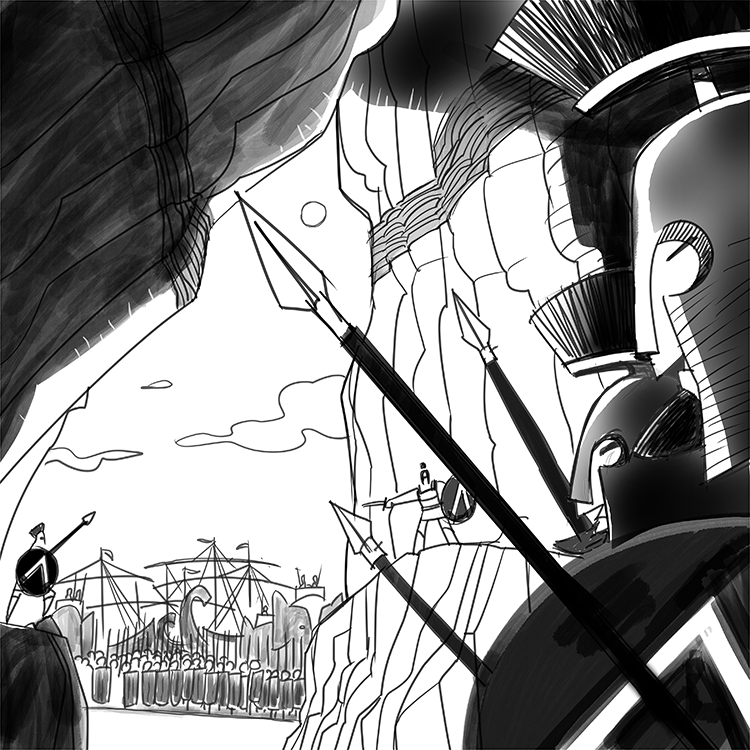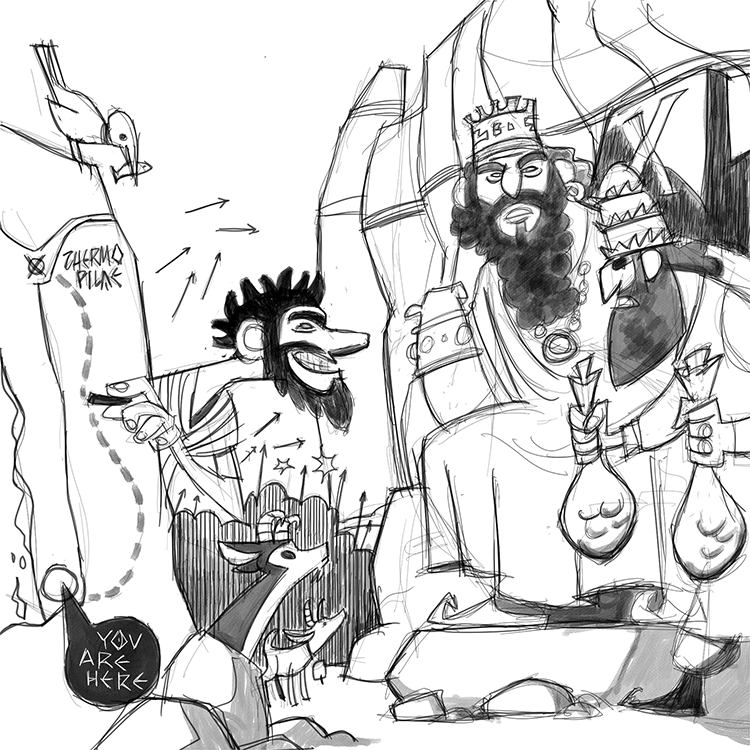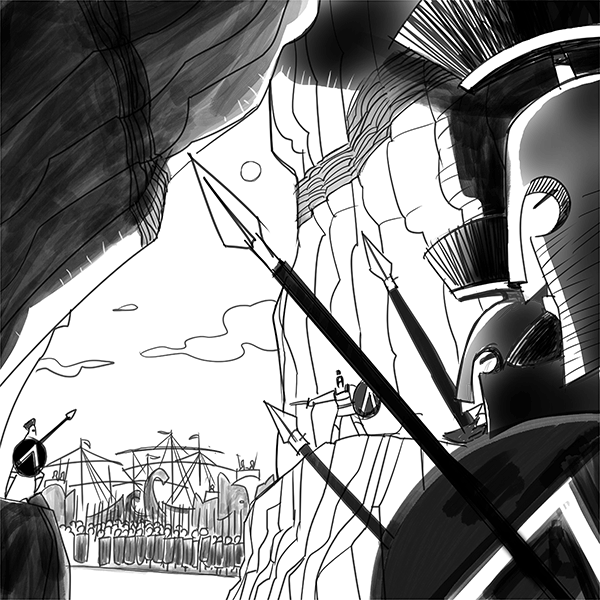
It’s easy to be romantic about the past. Looking back allows us to pick and choose what we want to see, and so often we like to glorify the good and ignore the bad.
One of the best examples of this is the Battle of Thermopylae. Plays, poems, and paintings have all been created to tell this story, and all of them focus on the valiant bravery of the Spartan army.”
According to legend, just 300 soldiers (often known as “the 300″) stood up to a Persian army that was more than a million strong.”
This sounds impressive, but it’s not exactly true. Still, the massively outnumbered Greek army did perform well. And despite losing the battle, their efforts made future victories possible, paving the way for a Greek victory in the much larger Greco-Persian Wars.

Initial Spartan Resistance
The Battle of Thermopylae was fought in 480 BC during what is known as the Second Persian Invasion of Greece. It was the third installment of a much larger conflict: the Greco-Persian War.
Hoping to finish what his father Darius had started, the Persian king Xerxes I built a truly massive army to invade Greece and conquer it.”
Seeing this invasion as a threat to their existence, the Athenians called on the rest of Greece for help. Any assistance would do, but they were most interested in recruiting the Spartans.”
At the time, the Spartan army was one of the most powerful of the ancient world.
In response to this plea for help from their archrivals, the Spartans at first said, “Fend for yourselves!”
Part of the reason Sparta initially refused to help was because they just didn’t like Athens. And being further from the threat made it seem smaller. But even the Spartans knew that letting Athens burn wouldn’t be good, so there was a sizable pro-war party within Sparta.
The other reason for Spartan resistance was timing. The battle was taking place during Sparta’s Carnea celebration. Held to celebrate the god Apollo, the Carnea was one of the most important religious festivals in ancient Sparta.
During this time, they weren’t supposed to go to war. And when they consulted the Oracle at Delphi to check this was still the case, they were told not to fight.”
This put the Spartan king Leonidas in a difficult position: go to war and anger the gods, or stay at home and wait to be destroyed. Talk about being put between a rock and a hard place.”
In the end, Leonidas found some middle ground. Instead of fully mobilizing his army, he chose to put together a small “expeditionary” force of volunteers. This is where the idea of the “300” was born.
This decision helps make the story of the Battle of Thermopylae more interesting. But at the time, it put the Greeks at a significant disadvantage in the most important fight of their history.

A Massively Uneven Match
No matter when the Persians invaded, they almost always outnumbered their enemy. This was the result of Persia’s massive size and influence. It could demand troops from lands both near and far, allowing it to build truly enormous fighting forces.”
But the army that invaded Greece in 480 BC took things to another level. Herodotus, the ancient Greek historian who wrote about the Greco-Persian Wars, estimates the Persian army numbered in the millions.”
Modern historians dismiss this as exaggeration and believe the Persians had no more than 180,000 soldiers in their force.”
The Greeks, on the other hand, had about 7,000.
Far more than the 300 Spartans from legend, but still a dramatic disadvantage. No wonder they were so scared.”
Still, the other option was to surrender and be destroyed. So, despite being so small as compared to Persia, the Greeks put on their armor, grabbed their spears, and marched for war.
The Battle of Artemisium
In addition to defending themselves at Thermopylae, the Greek alliance also decided to meet the Persian fleet at the nearby Cape of Artemisium. The idea was that by engaging the Persians there they could not only keep them far away from Athens, but they could also provide support for the land force fighting at Thermopylae.
It was here that the Greeks received a bit of good luck. On the eve of battle, a giant storm whipped up in the Aegean, pushing many Persian ships onto the rocks. In total, around half the fleet was lost. And this was before the Greeks even started fighting.
The actual Battle of Artemisium was rather anticlimactic. The Greeks arrived late, and then there was some confusion as to whether or not they should retreat. In the end, they were forced to give up their position, but not before the Persian fleet had been severely weakened.
Waiting for Surrender
Meanwhile, over at Thermopylae, the Persians and the Greeks were just hanging out. Xerxes, convinced of his victory, decided to wait three days for the Greeks to come to their senses and surrender. He figured that if they saw in person the size of his army, they would lay down their swords and shields and allow him to pass.
Turns out Xerxes miscalculated the Greeks’ desire to remain free, for they refused to surrender. Staring out at an army that’s about twenty times larger than yours must have been scary, but not so much as to avoid the battle.”

The Fighting Begins
On the fourth day after Xerxes arrived, he finally sent his troops into battle. But he soon realized why the Greeks hadn’t yet surrendered. The narrowness of the pass they were defending meant it didn’t really matter how many troops he had. He could only send a small number of them at a time.”
This significantly leveled the playing field and allowed the Greeks to fend off attack after attack from the Persians, and also kill lots and lots of Persian soldiers.
This continued for three days, and Xerxes was probably starting to get a little worried that he’d raised that massive army for nothing. But thanks to a timely betrayal from a disgruntled local — Ephialtes — the Persians learned there was an alternate route around the pass. Xerxes would send some of his best soldiers that way, allowing them to attack the Greeks from behind, and clearing the pass for his army.
Leonidas learned of this betrayal on the evening of the second day of fighting, and recognizing that it meant the end, sent the majority of his fighting force home. Only about 1,500 remained, the 300 from Sparta, some 400 Thebans, around 700 Thespians, and some Spartan slave soldiers.
In the legend, we tend to forget all of these other people, choosing to focus just on the “300.” But the Spartans were not alone.”
Still, this small inaccuracy doesn’t change the fact that the Greeks were doomed.
Finally, on the third day of fighting, Xerxes’ army snuck around the pass, slaughtering what remained of the Greek defense, and killing Leonidas as well.
The Battle of Thermopylae was over and was technically a Greek defeat. However, by inflicting so much damage on the Persian army, there was some hope that they could avoid total destruction. .But with Thermopylae lost, Xerxes likely saw little standing in his way of achieving his dream of conquering Greece. Two Major Defeats Give the Greeks Hope
Both the Battle of Thermopylae and its corresponding naval battle at Artemisium were resounding Persian victories, if all we care about is who won. But when we look more closely, the Greeks did surprisingly well.”
Thanks to Leonidas’ decision to let most of the defending force retreat the night before the final day of battle, the Greeks only lost a total of 4,000 men. In comparison, the Persians lost around 20,000.
Despite these losses, the Persian army was still significantly larger than that of the Greeks.” But their efforts at Thermopylae were more significant:” the Greeks now had hope. .”
Thanks to their” relative “success” at Thermopylae, the Greeks learned that their Greek fighting techniques, and superior armor and weapons, could keep the Persians at bay when they took up a strong defensive position, such as a narrow pass, a protected beach or bay, a hill, etc..”
Such information informed the Greek commanders as they prepared for the next battle. Thanks to this, plus the arrival of some much-needed reinforcements, mainly from Sparta but also from other parts of Greece, they were able to defeat the Persians once and for all at the Battle of Plataea. This effectively ended any future threats of invasion.
So, while the actual story doesn’t quite line up with the legend, it doesn’t take away from the significance of this battle. Sure, it was a defeat. But through defeat we learn, and the lessons the Greeks took from Thermopylae may have saved them from complete and total annihilation.”
Written by Matthew Jones
Illustrated by Pablo Velarde Diaz-Pache
